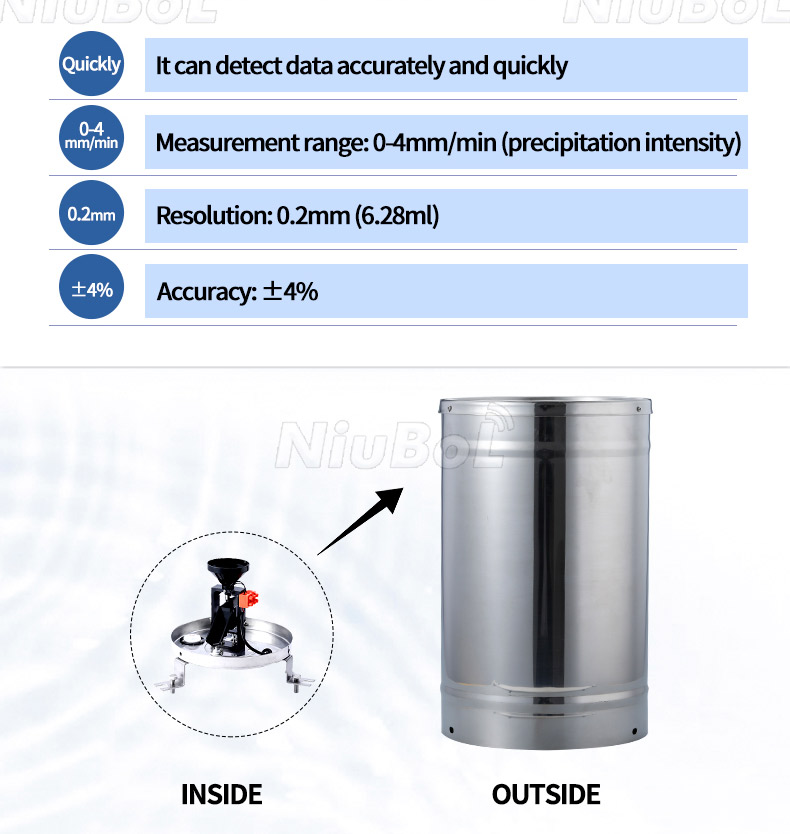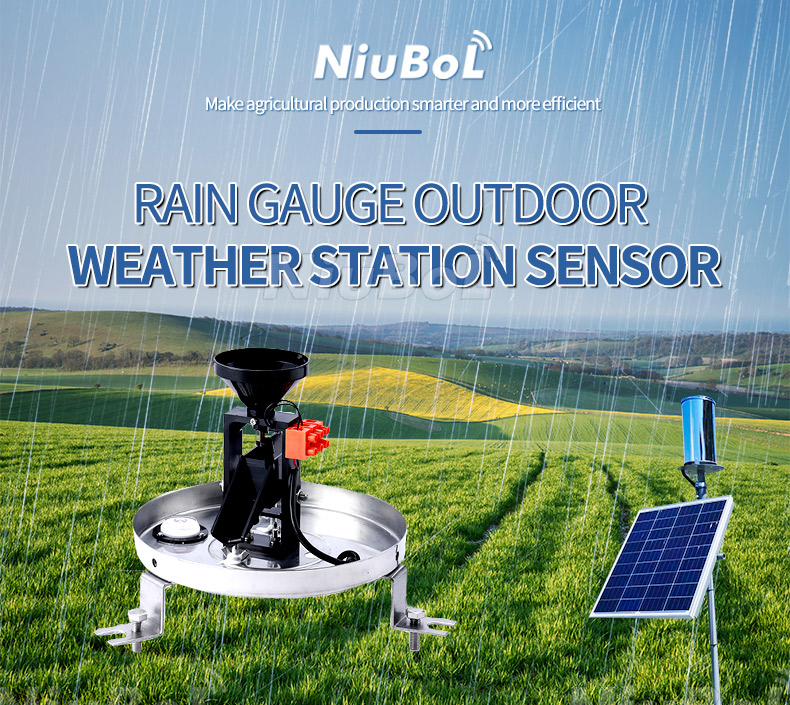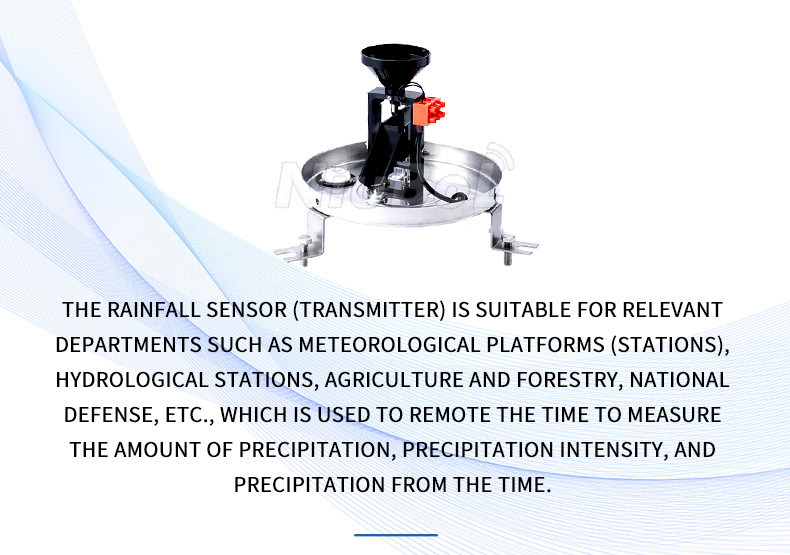

— Blogs —
—Products—
 Consumer hotline +8618073152920
Consumer hotline +8618073152920 WhatsApp:+8615367865107
Address:Room 102, District D, Houhu Industrial Park, Yuelu District, Changsha City, Hunan Province, China
Technical Support
Time:2023-08-30 14:47:55 Popularity:998
Rainfall sensors are devices used to measure the amount of rainwater that falls. They are widely used in fields such as meteorology, hydrology, agriculture, and urban planning to provide accurate rainfall data.
The working principles of common rainfall sensors are based on either a tipping bucket or vibration technology. Here are several types of commonly used rainfall sensors:
1. Tipping bucket rain gauge: This is a common and cost-effective rainfall sensor. It consists of a funnel that collects rainwater, causing the sensor to tip and record a certain amount of precipitation. This type of sensor is simple, durable, and suitable for most applications that require basic rainfall data.

2. Vibrating wire rain gauge: This sensor uses a vibrating wire and a receiver. When rainwater falls into the sensor, the collision of water droplets generates small vibrations, which the sensor detects and converts into rainfall data. Vibrating wire sensors can provide high accuracy even for smaller rainfall amounts.
3. Radar-based rain gauge: Radar technology provides more accurate rainfall measurements. This type of sensor uses radar beams to scan precipitation areas and calculates rainfall intensity and volume based on the reflected signals. Radar-based sensors are suitable for applications that require more precise spatial distribution and real-time rainfall data, such as weather forecasting and flood warning systems.
4. Optical rain gauge: Optical sensors measure rainfall by emitting and receiving light signals. When raindrops pass through the sensor, the light signal is obstructed and scattered, and the sensor calculates the amount of rainfall by detecting changes in the light signal. Optical sensors have high sensitivity to small raindrops and can provide more accurate rainfall data.
5. Multi-parameter rain gauge: In addition to measuring rainfall amounts, multi-parameter rain gauges can also measure other parameters such as rainfall intensity, temperature, and humidity. These sensors are suitable for applications that require comprehensive environmental monitoring and data collection.

Common failures and maintenance of rainfall sensors
As important equipment for measuring and recording rainfall, rainfall sensors are widely used in fields such as meteorology, water resource management, agriculture, and urban planning. However, due to long-term exposure to outdoor environments, rainfall sensors may encounter various failures. Therefore, regular maintenance and inspection are essential to ensure the accuracy and reliability of the sensors.
Here are some common rainfall sensor failures and their maintenance methods:
1. Decreased sensitivity: After a period of use, the sensitivity of rainfall sensors may decrease, resulting in inaccurate measurements. This may be caused by the accumulation of dust, corrosion, or deposits. Solutions include regularly cleaning the sensor surface and checking and clearing any blockages inside the sensor.
2. Funnel blockage: The funnel in a tipping bucket rain gauge may get clogged with leaves, insects, or soil, preventing the smooth entry of precipitation. To solve this issue, the funnel should be regularly inspected and any blockages cleared.

3. Signal interference: In radar-based and optical rainfall sensors, strong electromagnetic fields or foreign objects may cause signal interference, leading to inaccurate measurements. To avoid this problem, sensors should be kept away from sources of electromagnetic interference, and the surrounding environment should be kept clean.
4. Low battery power: For rainfall sensors powered by batteries, low battery power can cause the sensor to malfunction or result in incomplete data recording. Therefore, it is necessary to regularly check the battery power and replace the batteries in a timely manner.
5. Damage from lightning strikes: During thunderstorms, rainfall sensors may be damaged by lightning strikes. To minimize this risk, lightning protection devices can be installed or other protective measures taken to safeguard the sensors.
6. Regular calibration: Regular calibration is necessary to ensure the accuracy of measurements. Depending on the specifications and requirements of the sensor, regular calibration and adjustment should be performed to ensure measurement accuracy and consistency.
In summary, common failures of rainfall sensors include decreased sensitivity, funnel blockage, signal interference, low battery power, and damage from lightning strikes. Regular maintenance and inspection are necessary to maintain the accuracy and reliability of the sensors. This includes cleaning the sensor surface and interior, clearing the funnel, avoiding signal interference, regularly replacing batteries, and performing regular calibration. Through proper maintenance and repair, rainfall sensors will be able to provide reliable and accurate data, thereby supporting decision-making and planning in fields such as meteorology, water resource management, agriculture, and urban planning.
Weather-Stations-Catalog-NiuBoL-2024.pdf
Prev:Common Failures and Repair Tips for Wind Speed Sensors
Next:Meteorological Weather Station Troubleshooting, Repair Techniques, and Installation Requirements
Related recommendations
Sensors & Weather Stations Catalog
Agriculture Sensors and Weather Stations Catalog-NiuBoL.pdf
Weather Stations Catalog-NiuBoL.pdf
Related products
 Combined air temperature and relative humidity sensor
Combined air temperature and relative humidity sensor Soil Moisture Temperature sensor for irrigation
Soil Moisture Temperature sensor for irrigation Soil pH sensor RS485 soil Testing instrument soil ph meter for agriculture
Soil pH sensor RS485 soil Testing instrument soil ph meter for agriculture Wind Speed sensor Output Modbus/RS485/Analog/0-5V/4-20mA
Wind Speed sensor Output Modbus/RS485/Analog/0-5V/4-20mA Tipping bucket rain gauge for weather monitoring auto rainfall sensor RS485/Outdoor/stainless steel
Tipping bucket rain gauge for weather monitoring auto rainfall sensor RS485/Outdoor/stainless steel Pyranometer Solar Radiation Sensor 4-20mA/RS485
Pyranometer Solar Radiation Sensor 4-20mA/RS485
Screenshot, WhatsApp to identify the QR code
WhatsApp number:+8615367865107
(Click on WhatsApp to copy and add friends)